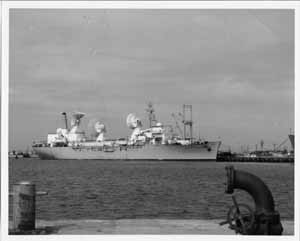
History of the Gen. Hoyt S. Vandenberg
Conversion | Commissioning | Atlantic Missile Range (AMR) | Advanced Range Instrumentation Ships (ARIS)|
Air Force Missile Test Center AFMTC | Hoyt Vandenberg Biography
 |
| OFFICE OF INFORMATION AIR FORCE MISSILE TEST CENTER PATRICK AIR FORCE BASE, FLORIDA USAFS GENERAL HOYT S. VANDENBERG
Work on the World War II troopers began in mid-summer 1961 after more than 5,000 sheets of engineering specifications had been written for each vessel. The conversions were handled by Bethlehem Steel Company's Brooklyn 56th Street Shipyard, where at the peak more than 1,500 men from the yard alone were engaged in the big transformation job. Final drydocking and bottom cleaning and painting were carried out by Bethlehem's Hoboken, N. Y., Shipyard. Displaying a profile to intrigue the most avid Buck Rogers fan -- visible on her superstructure are three 30 - to 40 - foot wide radar dishes mounted atop massive steel towers, two dome-like tracking structures, a multi-tiered forward bridge house, and a weather station and rocket launcher aft -- the GENERAL HOYT S. VANDENBERG, formerly the USNS General Taylor, is designed to extend the Air Force Missile Test Center's Atlantic Missile Range into the South Atlantic and Indian Oceans. So advanced and highly sophisticated is the instrumentation of the GENERAL VANDENBERG that the 14,300-ton vessel, officially known as a mobile tracking station, already has been dubbed a "floating Ascension Island" by the scientists and engineers who supervised the job for the Sperry Gyroscope Company, the prime contractor and systems management organization for the two ships. The firm of Gibbs & Cox were Design Agents for the conversions. Converting the 1944-vintage transport from the nation' s "mothball" fleet for duty in the space age required ingenuity of the highest order. Biggest phase of the Job was the installation of the electronic equipment and connecting cables. A total of 1400 cables had to be placed within the electronic spaces alone, while another 1,600 had to be installed to run between these spaces to link them to the master control console. Another vital task was the air-conditioning, de-humidifying and insulating of spaces containing delicate electronic computing devices. Of the vast quantities of pipe installed, for example, approximately 40,000 feet had to be specially insulated. Spaces housing the Univac military real-time computer, the central data conversion equipment, the operations control console, the radar systems, and the telemetry system demanded the most refined air-conditioning, sound-proofing and de-humidifying arrangements to insure against any possible malfunctioning or miscalculation. For this purpose and also to air-condition the living quarters, Bethlehem installed two 300-ton units and 300,000 square feet of thermal and acoustical insulation and lining. To provide the bulk of the power for the ship' s non-propulsive machinery and electronic equipment, Bethlehem installed three steam turbine-driven generators. These will produce a total of 6,000 kilowatts -- enough power to supply the residential needs of 18,0OO city dwellers. This installation required the building of an entirely new auxiliary machinery room. The ship itself is propelled by steam turbines developing 9,000 horsepower. A significant structural change involved the construction of massive foundations -approximating 70 tons - for each of the three radar antennas. Supports for these huge foundations had to be run all the way from the upper decks to the keel. For one foundation, the supports run through the machinery spaces. These unusual measures involving the use of heavy structural steel members, will eliminate the possibility of vibration damage to the radar mounts. One of the most difficult operations was the placing of three 80-ton, 22-foot high antenna mounts on each vessel. A U. S. Army derrick barge handled the big lifts. The mounts are designed to turn on ball bearings when the radars track a flying object. Bethlehem installed approximately 425,000 feet of cable on each ship. Some 540 "black boxes" containing the vital relays and electronic devices comprising the ship's radar, data handling, telemetry, meteorological, timing and communications equipment also were installed. About 40,000 wiring connections were made to these boxes by the shipyard workers alone. Thousands of other connections were made by some of the suppliers of this sophisticated equipment. The two ships -- the GENERAL ARNOLD and the GENERAL VANDENBERG -- have a length of 520 feet, a beam of 71 1/2 feet, and a sea speed of more than 17 knots. Each is a complete station for its two-hundred man crew, half of whom will devote their efforts solely to the ship's instrumentation. Each vessel has been outfitted with 636 compartments, including staterooms, storerooms, offices, a hospital, dining and recreational areas, a theater, laundries, lounges, lockers, galley, pantries -- virtually everything a land-based station has. All of the ship's present masts are completely new. The old stack was removed, and this system relocated farther aft with a new and higher stack to minimize the possibility of fuel gases interfering with the telemetry antenna. A complete weather station and hangar for weather balloons were built. Fact sheet provided by Air Force Missile Test Center, Patrick Air Force Base |
Streets of Reciefe | Norma & John at Ascension | Reciefe, Refueling | Freetown, Sierra Leone | Freetown, Sierra Leone2 | Ascension Pier | Ascension | At Dock | Halcyon Cove, Antigua | Kensington Inn Antigua |At sea | Bow view | Trident Pier | On the River | Winter at sea | Coming Home (Canaveral)|